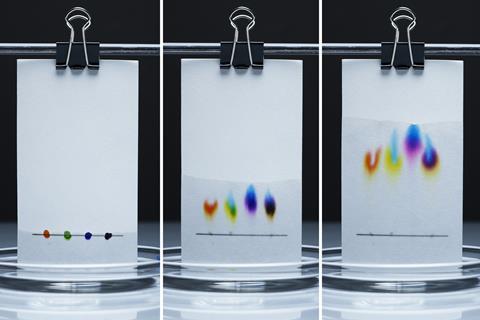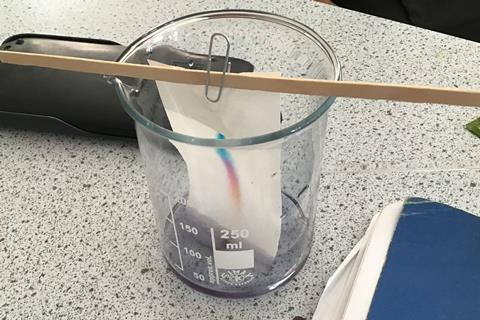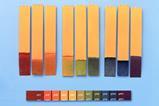Brighten up your chromatography lessons with these five teacher-tested ideas from teacher fellow Kristy Turner

Paper chromatography is often one of the first experiments students do in their science careers, sometimes even in primary school. It seems like a simple topic with some nice practical activities, but this simplicity can be misleading. It is a convenient technique with a long history, and it is still used in research today.
In a spiral curriculum, pupils will first meet paper chromatography in 11–14 chemistry, where the focus is carrying out simple experiments to find the numbers of components in mixtures. The focus then develops to building a greater understanding of the role of solubility and the mobile and stationary phases at 14–16, where students are expected to be able to describe and explain key elements of the separation.
1. Keep an easy pace
Don’t rush from introductory concepts into more complex science and, especially, don’t front-load the topic into 11–14. It can be tempting to rush as chromatography seems trivial to experts. Remember to view the curriculum through the novice lens. A broader understanding of concepts like the particle model and solubility supports better understanding of paper chromatography at higher levels. So, try not to bring those difficult concepts down into 11–14, and trust a spiral curriculum to support progression.
2. Add some colour to your lessons
Tailor your lessons to your students’ interests: students can find food fraud investigations or CSI-type activities really engaging. Chromatography of inks or food colourings is a common practical activity, but formulations change frequently so it’s not unusual for reliable experiments to suddenly stop working. Keep an eye on social media and resource sharing sites for new contexts for your experiments. Paper chromatography is very versatile and, with the right conditions, will separate many kinds of mixtures: pigments in leaves, components of universal indicators, amino acids and the coloured coating of hard-shelled sweets.

3. Do it wrong (on purpose)
Spotting the errors in diagrams of paper chromatography experiments is a common exam question, but it can be difficult for students to figure this out without first experiencing bad experiments. Engage students with concrete examples by showing them the effects of common errors. Do an experiment where too much solvent is used (washing the sample spots away), or where the origin line is drawn in pen, obscuring the results.
4. Mix it up
Don’t just use water as the solvent or mobile phase. It’s a convenient and safe substance to work with and, of course, it’s a good solvent, but it doesn’t always give the best separations for different mixtures. Just using water can also mean students assume that the solvent will always be water and lead to them not carefully examining the information given in questions. Try switching water for salt solutions when separating inks for better resolution of the different colours. For older students look at how different ratios of ethanol:water in solvent mixtures change how far the components of mixtures travel up the paper and the effect of Rf.
More ideas for mastering chromatography
- Check out this collection of useful videos full of paper chromatography experiments.
- Enhance your approach to practical chromatography with this CPD guide.
- Roll out the kitchen roll for this idea for classroom or home activity.
5. Be ambitious but supportive with terminology
Teach the language of the processes and their explanations explicitly. Chromatography, from ‘chroma’ meaning colour and ‘graph’ meaning to record, stationary phase (not stationery – ‘e’ is for envelopes, after all), mobile phase, origin, solvent front, chromatogram. Practise the use of correct terms using recall items, fill-in-the-blanks exercises and short answers to build student confidence. Where students are really struggling in their explanations and descriptions, ease the cognitive load by providing them with keyword lists to refer to as they work their way through questions.














3 readers' comments